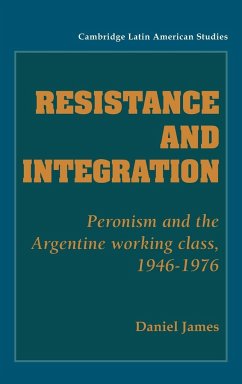- Gebundenes Buch
- Merkliste
- Auf die Merkliste
- Bewerten Bewerten
- Teilen
- Produkt teilen
- Produkterinnerung
- Produkterinnerung
A solidly researched, persuasive study of the Argentine labour movement which analyses the relationship between Peronism and the Argentine working class.
Andere Kunden interessierten sich auch für
![Reverence, Resistance and Politics of Seeing the Indian National Flag Reverence, Resistance and Politics of Seeing the Indian National Flag]() Sadan JhaReverence, Resistance and Politics of Seeing the Indian National Flag85,99 €
Sadan JhaReverence, Resistance and Politics of Seeing the Indian National Flag85,99 €![Football and Integration in Plano, Texas: Stay in There, Wildcats! Football and Integration in Plano, Texas: Stay in There, Wildcats!]() The Plano Conservancy for Historic PreseFootball and Integration in Plano, Texas: Stay in There, Wildcats!24,99 €
The Plano Conservancy for Historic PreseFootball and Integration in Plano, Texas: Stay in There, Wildcats!24,99 €![Becoming New York's Finest Becoming New York's Finest]() A. DarienBecoming New York's Finest38,99 €
A. DarienBecoming New York's Finest38,99 €![European Integration European Integration]() European Integration146,99 €
European Integration146,99 €![Pozuzo Pozuzo]() Wilfried SchabusPozuzo26,90 €
Wilfried SchabusPozuzo26,90 €![Invisible Generals Invisible Generals]() Doug MelvilleInvisible Generals38,99 €
Doug MelvilleInvisible Generals38,99 €![Hoops Hoops]() Thomas AielloHoops30,99 €
Thomas AielloHoops30,99 €-
-
-
A solidly researched, persuasive study of the Argentine labour movement which analyses the relationship between Peronism and the Argentine working class.
Produktdetails
- Produktdetails
- Verlag: Cambridge University Press
- Seitenzahl: 312
- Erscheinungstermin: 21. April 1988
- Englisch
- Abmessung: 235mm x 157mm x 23mm
- Gewicht: 659g
- ISBN-13: 9780521346351
- ISBN-10: 0521346355
- Artikelnr.: 22897235
- Herstellerkennzeichnung
- Libri GmbH
- Europaallee 1
- 36244 Bad Hersfeld
- gpsr@libri.de
- Verlag: Cambridge University Press
- Seitenzahl: 312
- Erscheinungstermin: 21. April 1988
- Englisch
- Abmessung: 235mm x 157mm x 23mm
- Gewicht: 659g
- ISBN-13: 9780521346351
- ISBN-10: 0521346355
- Artikelnr.: 22897235
- Herstellerkennzeichnung
- Libri GmbH
- Europaallee 1
- 36244 Bad Hersfeld
- gpsr@libri.de
Daniel James is an author of speculative fiction from Liverpool, England. He is the recipient of 3 Kirkus Star reviews for his supernatural fantasy thrillers Hourglass, The Ferryman's Toll, and the upcoming Hair-Trigger Smile. Hourglass was also voted one of their Best 100 Indie novels of 2021.He is represented by Laurie Blum Guest at Re-Naissance Agency. Daniel first began writing as a hobby and creative outlet to distract himself from the mundanity of completing his Bachelors of Science at Liverpool Hope University. Growing up, he spent perhaps a little too much time daydreaming about superheroes and horror movies. In his mid-teens he got his first bass guitar and joined his first rock band, and growing up he maintained this interest in music, playing in several other bands and gigging locally, which is one of the reasons why he always insists on putting music in his novels.
Acknowledgements
Introduction
Part I. The Background: 1. Peronism and the working class, 1943-55
Part II. The Peronist Resistance, 1955-8: 2. The survival of Peronism: resistance in the factories
3. Commandos and unions: the emergence of the new Peronist union leadership
4. Ideology and consciousness in the Peronist resistance
Part III. Frondizi and Integration: Temptation and Disenchantment, 1958-62: 5. Resistance and defeat: the impact on leaders, activists and rank and file
6. The corollary of institutional pragmatism: activists, commandos and elections
Part IV. The Vandor Era: 1962-6
7. The burocracia sindical: power and politics in Peronist unions
8. Ideology and politics in Peronist unions: different currents within the movement
Part V. Workers and the Revolución Argentina: from Onganía to the Return of Perón, 1966-73
9. The Peronist union leaders under siege: new actors and new challenges
10. Conclusion
Notes
Select bibliography
Index.
Introduction
Part I. The Background: 1. Peronism and the working class, 1943-55
Part II. The Peronist Resistance, 1955-8: 2. The survival of Peronism: resistance in the factories
3. Commandos and unions: the emergence of the new Peronist union leadership
4. Ideology and consciousness in the Peronist resistance
Part III. Frondizi and Integration: Temptation and Disenchantment, 1958-62: 5. Resistance and defeat: the impact on leaders, activists and rank and file
6. The corollary of institutional pragmatism: activists, commandos and elections
Part IV. The Vandor Era: 1962-6
7. The burocracia sindical: power and politics in Peronist unions
8. Ideology and politics in Peronist unions: different currents within the movement
Part V. Workers and the Revolución Argentina: from Onganía to the Return of Perón, 1966-73
9. The Peronist union leaders under siege: new actors and new challenges
10. Conclusion
Notes
Select bibliography
Index.
Acknowledgements
Introduction
Part I. The Background: 1. Peronism and the working class, 1943-55
Part II. The Peronist Resistance, 1955-8: 2. The survival of Peronism: resistance in the factories
3. Commandos and unions: the emergence of the new Peronist union leadership
4. Ideology and consciousness in the Peronist resistance
Part III. Frondizi and Integration: Temptation and Disenchantment, 1958-62: 5. Resistance and defeat: the impact on leaders, activists and rank and file
6. The corollary of institutional pragmatism: activists, commandos and elections
Part IV. The Vandor Era: 1962-6
7. The burocracia sindical: power and politics in Peronist unions
8. Ideology and politics in Peronist unions: different currents within the movement
Part V. Workers and the Revolución Argentina: from Onganía to the Return of Perón, 1966-73
9. The Peronist union leaders under siege: new actors and new challenges
10. Conclusion
Notes
Select bibliography
Index.
Introduction
Part I. The Background: 1. Peronism and the working class, 1943-55
Part II. The Peronist Resistance, 1955-8: 2. The survival of Peronism: resistance in the factories
3. Commandos and unions: the emergence of the new Peronist union leadership
4. Ideology and consciousness in the Peronist resistance
Part III. Frondizi and Integration: Temptation and Disenchantment, 1958-62: 5. Resistance and defeat: the impact on leaders, activists and rank and file
6. The corollary of institutional pragmatism: activists, commandos and elections
Part IV. The Vandor Era: 1962-6
7. The burocracia sindical: power and politics in Peronist unions
8. Ideology and politics in Peronist unions: different currents within the movement
Part V. Workers and the Revolución Argentina: from Onganía to the Return of Perón, 1966-73
9. The Peronist union leaders under siege: new actors and new challenges
10. Conclusion
Notes
Select bibliography
Index.









